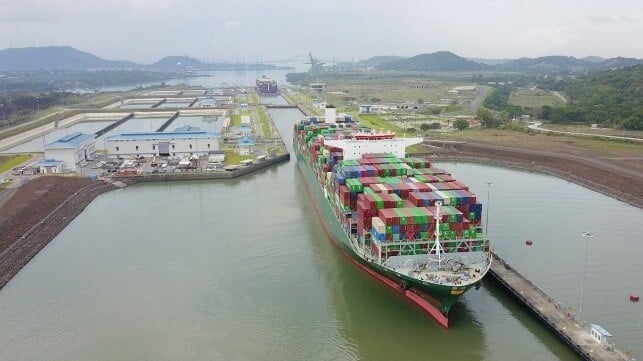Panama Canal Continues to Restore Capacity While Warning of Water Concerns

The Panama Canal Authority is accelerating its efforts to build back capacity at the canal while also providing for increased vessel draft as the region is now in the rainy season. While the canal is returning to normal levels the authorities however warn that the long-term impact of climate variability and the challenges of securing water remain.
The draft which had been a major concern for the larger containerships and gas carriers is returning to normal levels. As of the end of May, the Authority moved it back to 45 feet as the maximum authorized draft. Yesterday, they said effective immediately it was going to 47 feet from the prior 46-foot mark and further on July 11 they will increase it to 48 feet.
A year ago, the Panama Canal had been working with a 44-foot draft limit while taking steps to maintain the draft by reducing the number of daily transit slots as well as water conservation such as a process known as double locking. Still, large containerships were having to transship boxes across the isthmus by train, and gas carriers were diverting. As the canal moves up to the new levels these steps are no longer needed. The canal has operated at 50 feet when water levels are strong.
The canal is also further increasing the number of daily transits back to 35 as of August 5. The plan calls for a series of steps moving from 32 to 33 on July 11 and to 34 on July 22. The additional slot will be at the larger Neopanamax locks which will be restored to 10 daily transits.
These steps came as the Panama Canal Authority highlights it is eight years since the expanded canal opened on June 26, 2016. They report since then more than 25,000 vessels have transited the Neopanamax locks. Between October 2023 and May 2024 despite the restrictions they note 1,799 vessels transited the expanded canal. Nearly two-thirds (662.4 percent) were containerships.
The U.S. Energy Information Administration advises in a new analysis, “The APC expects more rainfall during the rainy season that lasts from May to December because of an expected La Niña this summer, which could result in normal operations this summer or fall.”
While that is good news for the operations, the authority also warns that the long-term effects are still a concern. They advised despite the arrival of the rainy season in 2024, the challenges of water for Panama and the Panama Canal remain.

that matters most
Get the latest maritime news delivered to your inbox daily.
“Potential solutions include the identification of alternative sources of water from the 51 watersheds and lakes in Panama, along with projects that can increase storage capacity to ensure water availability for the entire Panamanian population and the canal’s operation, thereby ensuring its long-term sustainability,” they write in the latest update. “At the same time, the Panama Canal is exploring additional short- and long-term solutions that can optimize the use and storage of water at the canal for the benefit of both the local population and its own operations.”
The Panama Canal Authority writes that it understands the critical role of the canal in commerce. They report between 13,000 and 14,000 vessels transit each year. The waterway serves more than 180 shipping routes, connecting 170 countries, and approximately 1,920 ports around the world.
